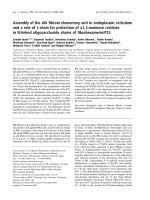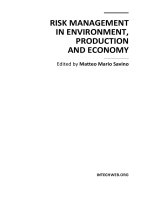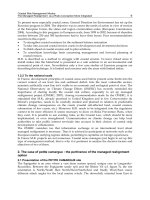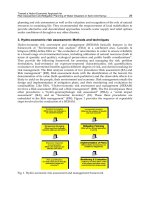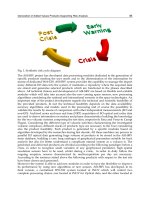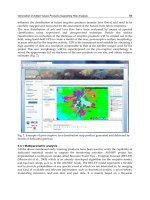WORKING CAPITAL MANAGEMENT
Bạn đang xem bản rút gọn của tài liệu. Xem và tải ngay bản đầy đủ của tài liệu tại đây (3.15 MB, 131 trang )
Graduation Thesis
Academy of Finance
MINISTRY OF FINANCE
ACADEMY OF FINANCE
----------------
......
CQ55/11.14
GRADUATION THESIS
TOPIC:
WORKING CAPITAL MANAGEMENT AT HUNG CUONG
INVESTMENT AND CONSTRUCTION JOINT STOCK COMPANY
Major:
Code :
Supervisor:
HA NOI – 2021
1
CQ55/11.14
Graduation Thesis
Academy of Finance
MINISTRY OF FINANCE
ACADEMY OF FINANCE
----------------
2
CQ55/11.14
Graduation Thesis
Academy of Finance
DECLARATION
I hereby pledge that this thesis is done on my own research due to the
three-month internship at Hung Cuong Investment and Construction Joint
Stock Company. The data and results used in my graduation thesis are
genuinely come from the actual situation of the internship company.
Graduation thesis author
3
CQ55/11.14
Graduation Thesis
Academy of Finance
ACKNOWLEDGEMENTS
In graduate study and training, I always receive the attention, guidance,
and dedicated help of the Board of Directors of the Academy of Finance, the
teachers in the academy in general, and the teacher in the Faculty of
Corporate Finance in particular.
To complete this thesis, I would like to extend my sincere thanks to The
Board of Directors of the Academy of Finance has facilitated the facilities
with a modern library system convenient for searching and researching
information from books and documents.
In particular, I would like to express my deep gratitude to Assoc. Prof.
Pham Thi Thanh Hoa for directly helping, commenting, and giving valuable
advice to help my essay become more complete.
I would also like to thank the Board of Directors and staff in the
Financing – Account Department of Hung Cuong Investment and
Construction Joint Stock Company for creating conditions and helping me
during my internship here.
Graduation thesis author
4
CQ55/11.14
Graduation Thesis
Academy of Finance
TABLE OF CONTENTS
CHAPTER 1: OVERVIEW OF WORKING CAPITAL AND WORKING
CAPITAL MANAGEMENT...................................................................................4
1.1
Working capital and company’s working capital financing...................4
1.1.1
Definition and features of working capital..............................................4
1.1.1.1 Definition....................................................................................................4
1.1.1.2 Features.......................................................................................................5
1.1.2
Classification of working capital..............................................................6
1.1.3
Working capital financing.........................................................................7
1.2
Working capital management....................................................................9
1.2.1
Definition and objectives of working capital management....................9
1.2.1.1 Definition....................................................................................................9
1.2.1.2 Objectives of working capital management............................................9
1.2.2
The content of working capital management........................................10
1.2.2.1 Determination of working capital needs and working capital
financing............................................................................................................... .10
1.2.2.2 Components of working capital..............................................................17
1.2.2.3 Cash management....................................................................................18
1.2.2.4 Accounts receivable management..........................................................20
1.2.2.5 Inventory management............................................................................21
1.2.3
Indicators to evaluate working capital management............................24
1.2.3.1 Indicators to evaluate working capital financing management...........24
1.2.3.2 Indicators to evaluate structure of working capital investment...........25
5
CQ55/11.14
Graduation Thesis
Academy of Finance
1.2.3.3 Indicators to evaluate cash management...............................................26
1.2.3.4 Indicators to evaluate accounts receivable management......................27
1.2.3.5 Indicators to evaluate inventory management.......................................27
1.2.3.6 Indicators to evaluate working capital management............................28
1.2.4. Determinants of working capital management......................................29
1.2.4.1 Subjective factors....................................................................................29
1.2.4.2 Objective factors......................................................................................30
CHAPTER 2: HUNG CUONG INVESTMENT AND CONSTRUCTION
JOINT STOCK COMPANY.................................................................................32
2.1
Overview of Hung Cuong Investment and Construction Joint Stock
Company……........................................................................................................32
2.1.1
The establishment and development of Hung Cuong Investment and
Construction Joint Stock Company.....................................................................32
2.1.2
Business characteristics of Hung Cuong Investment and Construction
Joint Stock Company............................................................................................33
2.1.2.1 Business field and major business line..................................................33
2.1.2.2 Organizational structure of the company...............................................33
2.1.2.3 Characteristics of business activities:....................................................36
2.1.2.4 Characteristics of input and output market...........................................37
2.1.2.5 Material and technical basis:..................................................................38
2.1.2.6 Labor force...............................................................................................39
2.1.3
Overview of financial performance of Hung Cuong Investment and
Construction JSC...................................................................................................39
2.1.3.1 The business operation situation of the company in recent years.......39
2.1.3.2 The financial performance of the company in recent years.................43
6
CQ55/11.14
Graduation Thesis
2.2.
Academy of Finance
Working capital management of Hung Cuong Investment and
Construction JSC………………..........................................................................50
2.2.1
Working capital and structure of working capital investment.............50
2.2.2
Working capital financing management................................................54
2.2.3
Determining the needs for working capital...........................................60
2.2.4
Cash management....................................................................................61
2.2.4.1 ........The situation of cash management at Hung Cuong Investment and
Construction JSC...................................................................................................61
2.2.4.2 The results of cash management at Hung Cuong Investment and
Construction JSC...................................................................................................62
2.2.5
Inventory management............................................................................68
2.2.5.1 The situation of inventory management at Hung Cuong Investment
and Construction JSC...........................................................................................68
2.2.5.2 The results of inventory management at Hung Cuong Investment and
Construction JSC...................................................................................................69
2.2.6
Accounts Receivable management.........................................................74
2.2.6.1 The situation of accounts receivable management at Hung Cuong
Investment and Construction JSC........................................................................74
2.2.6.2
The results of accounts receivable management at Hung Cuong
Investment and Construction JSC........................................................................75
2.2.7
Evaluation indicators of working capital management........................81
2.3
Assessment of working capital management.........................................85
2.3.1
The achievements....................................................................................85
2.3.2
The shortcomings and reasons................................................................86
7
CQ55/11.14
Graduation Thesis
Academy of Finance
CHAPTER 3: SOLUTIONS TO IMPROVE WORKING MANAGEMENT OF
HUNG CUONG INVESMENT AND CONSTRUCTION JOINT STOCK
COMPANY............................................................................................................89
3.1.
Objectives and targeted performance of Hung Cuong Invesment and
Construction JSC...................................................................................................89
3.1.1
Socio-economic situation in the future..................................................89
3.1.2. The targeted performance of Hung Cuong Investment and Construction
JSC……………......................................................................................................90
3.1.2.1 Non-financial goals.................................................................................90
3.1.2.2 Financial goals.........................................................................................91
3.2.
Solutions to improve working capital management of company.........92
3.2.1. Improve working capital needs determination......................................92
3.2.2. Strengthen the management of receivables and minimize amount of
capital occupied.....................................................................................................94
3.2.3. Well managing inventory and determining the inventory reserve level
reasonably to save costs.......................................................................................96
3.2.4. Managing strictly and improving the efficiency of using capital in
cash, determining the level of cash reserve reasonably and using idle cash
capital efficiently...................................................................................................98
3.3.
Conditions needed for implementing the solution................................99
CONCLUSION....................................................................................................101
REFERENCES....................................................................................................103
8
CQ55/11.14
Graduation Thesis
Academy of Finance
LIST OF ABBREVIATIONS
BEP:
Basic Earning Power
EBT:
Earning before tax
EOQ:
Economic Order Quantity
GDP:
Gross domestic product
Hung Cuong Investment and Construction JSC: Hung Cuong
Investment and Construction Joint Stock Company
NWC:
Net working capital
ROA:
Return on Assets
ROE:
Return on Equity
ROS:
Return on Sales
VND:
Vietnamese Dong
9
CQ55/11.14
Graduation Thesis
Academy of Finance
LIST OF TABLES
Page
42
Table 2.1
Business performance in recent years of Hung Cuong
Table 2.2
Invesment and Construction JSC
Assets and asset structure in recent years of Hung
48
Table 2.3
Cuong Invesment and Construction JSC
Labilities and sharholders’ equity of Hung Cuong
49
Table 2.4
Invesment and Construction JSC
The structure of working capital investment of Hung
53
Table 2.5
Cuong Investment and Construction JSC
Net working capital of Hung Cuong Invesment and
56
Table 2.6
Construction JSC in 2019 and 2020
Structure and fluctuations of the working capital of
57
Hung Cuong Investment and Construction JSC in 2019
Table 2.7
Table 2.8
and 2020
Temporary capital to finance working capital of Hung
Cuong Investment and Construction JSCin 2019 and
2020
Detail situation of cash and cash quivalents in the stage
59
63
of Hung Cuong Investment and Construction JSC in
Table 2.9
2019 and 2020
Liquidity ratios of Hung Cuong Investment and
Table 2.11
Construction JSC in 2019 and 2020
Compare liquidity ratios of Hung Cuong Investment
and Construction JSC with the average of the industry.
The structure of inventory of Hung Cuong Investment
Table 2.12
and Construction JSC in 2019 and 2020
The efficiency of inventory management of Hung
Table 2.10
64
67
71
73
Cuong Investment and Construction JSC in 2019 and
Table 2.13
2020
Structure and fluctuation of receivables in 2019 and
78
2020.
10
CQ55/11.14
Graduation Thesis
Table 2.14
Academy of Finance
Receivable turnover and Average collection period of
79
Hung Cuong Investment and Construction JSC in 2019
Table 2.15
and 2020
The situation of receivables and payables of Hung
80
Table 2.16
Cuong Investment and Construction JSC
Indicators to evaluate working capital management of
84
Table 3.1
Hung Cuong Investment and Construction JSC
Targets planned by the company in the coming year
92
11
CQ55/11.14
Graduation Thesis
Academy of Finance
LIST OF FIGURES
Page
6
15
16
16
23
23
34
Figure 1.1
Figure 1.2
Figure 1.3
Figure 1.4
Figure 1.5
Figure 1.6
Figure 2.1
Cycle of working capital
First funding model
Second funding model
Third funding model
The EOQ model
Quantity of re-orders
Diagram of the company’s managementapparatus
Figure 2.2
Figure 2.3
Financial and accounting department structure diagram
Construction process of Hung Cuong Investment and
36
37
Figure 2.4
Figure 2.5
Figure 2.6
Construction JSC
Overview of assets volatility of the company (2018-2020)
Overview of equity volatility of the company (2018-2020)
Components of working capital of Hung Cuong
43
46
50
Figure 2.7
Investment and Construction JSC
Capital financing model of Hung Cuong Investment and
55
Figure 2.8
Construction JSC
The company’s process of importing and exporting
69
warehouses
12
CQ55/11.14
Graduation Thesis
Academy of Finance
PREFACE
1. Rationale of the thesis
In manufacturing and business activities or any other manufacturing
sector, capital in general and working capital, in particular, have an essential
role. The working capital of a business is compared to blood circulating in the
human body because of the similarities between their circulation and
necessity. Working capital attends to most of the business activities such as
storing, producing, and conducting. It is like the lubricant which helps
businesses exist and operate smoothly.
In the current market economy, the demand of businesses for working
capital is becoming more desperate. Businesses have to directly face the
market volatility as well as the competition from domestic businesses and
international partners, which requires a rational usage of working capital in
order to get the maximum benefits and improve competitiveness. On the other
hand, to enlarge the production scale, businesses need to try everything to
raise the capital and especially the working capital, so the competition in the
working capital market is getting more intensive.
The indicators relating to working capital are significant for finance
managers because these indicators have a close connection with the money
businesses need to maintain normal operations. In other words, working
capital is the expression as money of the entire current assets of businesses.
For any investors, the indicator of managing working capital efficiency
is a significant standard to decide whether to invest or not. A business can
have positive revenue, high assets value, and large scale of capital, but those
are not enough to assure the financial situation. Money can still congeal in
1
CQ55/11.14
Graduation Thesis
Academy of Finance
storing and conducting terms, businesses can be unable to afford the payment
since they can not collect debts from borrowers, etc. Considering these
indicators helps investors minimum risk and increase their investing
efficiency.
Awarding the importance of working capital and improving working
capital efficiency, together with internship at company and previous
knowledge, I suppose working capital of Hung Cuong Investment and
Construction Joint Stock Company needs to be studied deeper, and that is the
reason I choose the subject “Working capital management at Hung Cuong
Investment and Construction Joint Stock Company”.
1. Research objectives of the thesis.
Object of study: Working capital management of a company.
Scope of study:
- Space: The study was about the case of Hung Cuong Investment and
Construction Joint Stock Company.
- Period: 2019 – 2020.
Study objectives: This study aimed at three main points:
- Firstly, overview of theories of working capital management of a
company.
- Secondly, analyzing the current situation of the working capital
management atHung Cuong Investment and Construction from that indicating
achievements and limitations.
2
CQ55/11.14
Graduation Thesis
Academy of Finance
- Thirdly, proposing some solutions to enhance the working capital
management of Hung Cuong Investment and Construction JSC in the coming
years.
2. Scope of the study.
In theory: Systematize the basic theory of working capital management
at the company.
In practical terms: Study the working capital management at the Hung
Cuong Investment and Construction Joint Stock Company and propose some
major solutions to improve the situations at Hung Cuong Investment and
Construction Joint Stock Company
3. Research methodology.
To analyze and assess the current situation of working capital
management, from that propose solutions to enhance working capital
management at Hung Cuong Investment and Construction JSC, I use the
following research methods: comparative statistical method, aggregation of
data method, method of assessment of the influence level and trends of
indicators and other methods. Besides, to collect the data, I also use some
methods such as: collecting the data related to research.
4. The structure of the thesis
Besides the Contents, Preface, Conclusion and references, the thesis
consists of three main chapters:
Chapter 1: Theoretical background of working management of a company.
Chapter 2: Working capital management at Hung Cuong Investment and
Construction JSC.
3
CQ55/11.14
Graduation Thesis
Academy of Finance
Chapter 3: Solutions to improve working capital management at Hung
Cuong Investment and Construction JSC.
CHAPTER 1:OVERVIEW OF WORKING CAPITAL AND WORKING
CAPITAL MANAGEMENT
1.1 Working capital and company’s working capital financing.
1.1.1 Definition and features of working capital
1.1.1.1 Definition
All companies must have a particular amount of monetary capital to
ensure operations run smoothly and continuously. The total amount of money
used to acquire necessary assets to produce the goods and/or services is
known as a company's capital. There are two types of corporate finance: fixed
assets and working capital. Fixed assets such as lands, buildings, machinery,
and so on. While working capital is used to purchase raw materials and pay
the day-to-day expenses like salaries, rent, electricity bills, etc. The initial
amount of money invests into fixed assets or working capital.
According to Article 4 of Vietnamese Enterprise Law 2020:
“Enterprise means an organization that has its own name, assets and a
transaction office, and has been registered for establishment in accordance
with law for the purpose of conducting business operations”. In addition, the
law also defines “Business as the continuous implementation of one, some
or all of the stages of an investment process, from the production to the sale
of products or the provision of services on the market to make a profit”. An
enterprise is an economic organization that conducts an ongoing business
4
CQ55/11.14
Graduation Thesis
Academy of Finance
process and produces or provides powerful services in the marketplace to
make a profit.
In order to carry out production and business activities, enterprises
must have the basic elements such as labor materials, labor objects, and labor
capacity. In which, the labor objects only participate in one production cycle
and do not maintain the original physical form. Its value is transferred wholly
and once to the value of the product. The working objects mentioned above in
terms of physical form are called the current assets. Based on the enterprise's
scope of assets, the enterprise is usually divided into two parts: production
current assets and circulation current assets. In the process of business,
production and circulation current assets are always moving, transforming,
replacing each other, ensuring the production process is maintained.
Thus, it can be said: Working capital is the total amount of advance
that an enterprise invests in forming regular current assets necessary for
production and business activities of an enterprise.
1.1.1.2 Features
In the process of participating in production and business activities, due to
its nature as a source of working assets in the enterprise, working capital also has
some characteristics that show the impact of working assets as follows:
Working capital always changes the expression in the process of
transferring value through the stages of production and business of enterprises:
From the form of initial monetary capital into materials, and goods in reserve for
production, then unfinished products, semi-finished products, finished products
and finally return to the capital form with money.
5
CQ55/11.14
Graduation Thesis
Academy of Finance
Working capital shifted the whole value right in one time into the value
of manufactured goods and services and fully recovered when the enterprise
earned money from selling goods and services and ending the business cycle.
Working capital completes a circulation after each business cycle.
On the basis of the aforementioned characteristics, it can be seen that at
the same time, working capital in the enterprise exists in many manifestations with
different roles and characteristics for business activities. Therefore, it is necessary
for enterprises to take measures to manage working capital in a rational,
synchronized, and closely interconnected manner. In addition, with the
management of working capital, enterprises also need to focus on applying several
necessary tools and policies, thereby speeding up the working capital cycle,
shortening the working capital rotation period, and at the same time, building a
suitable short-term capital structure for working capital investment in order to
contribute to improving capital efficiency.
Figure 1.1. Cycle of working capital
1.1.2 Classification of working capital
6
CQ55/11.14
Graduation Thesis
Academy of Finance
To manage and use working capital efficiently, we need to classify
working capital according to certain criteria. There are usually the following
major types of classification:
Classified according to the form of working capital:
Inventories: can be further divided into inventories of raw materials,
work in progress, and finished goods.
Accounts receivable: mainly receivables from customers, which
refer to the amount of money that the company has the right to collect from
customers in payment.
Cash and Cash Equivalent: money is a component of the current
asset, which is the most liquid asset. Therefore, each company needs to ensure
that it always has available money to meet the company's day-to-day debts
and a small reserve on hand to meet contingencies.
Classified according to the role of working capital:
Working capital in storage (including capital of raw materials, fuel,
spare parts, small tools for production reserves).
Working capital in production (including semi-finished capital,
unfinished products, capital of prepaid expenses).
Working capital in circulation (consists of: capital of finished
products, capital in payment, short – term investment capital, capital in cash).
1.1.3 Working capital financing.
Working capital financing is done by various modes such as trade credit,
cash credit/bank overdraft, working capital loan, purchase of bills/discount of
7
CQ55/11.14
Graduation Thesis
Academy of Finance
bills, bank guarantee, letter of credit, factoring, commercial paper, intercorporate
deposits, etc.
Working capital and working capital financing are closely tied in the
business because the material form of the material itself is the current assets.
Each business's working capital structure is different, as is the basis of its
creation. It is necessary to think about choosing the best capital structure so
that both lowering capital costs and ensuring the production and business
processes are important issues for each company.
Working capital financing includes permanent and temporary working
capital.
Regular capital: is the amount of stable long-term capital sources
available to companies for use in development and operations. This fund is
often used to purchase fixed assets, and a part of fixed assets is often
necessary for the business and manufacturing processes of the company.The
following formula can determine regular capital at a time:
Regular capital = Owner’s equity + Non-current liability
Regular capital = Total asset – Current liability
On the basis of calculating the regular capital, we will calculate the net
working capital by using following formula:
Net working capital = Current assets - Current liabilities
Net working capital = Regular capital - Fixed assets
Net working capital can provide a level of safety for companies in
terms of output and business activities.
8
CQ55/11.14
Graduation Thesis
Academy of Finance
Temporary capital: is described as the amount of short-term capital
(typically less than one year) that businesses can use to meet the temporary
needs of production and business operations. Short-term loans from banks or
financial institutions, as well as other short-term debts, are common sources
of temporary funds. This is also an essential source of capital for meeting the
capital needs that arise during the manufacturing process.
Temporary working capital is a type of short-term capital used to fund a
company's working capital in order to meet the fluctuations of the business
cycle.Temporary working capital is identified as follows:
Temporary working capital = Short-term loan + Occupied capital
Each funding source has its own set of benefits and limitations. Businesses
must consider factors such as cash flow, discount rates, and cost of capital when
deciding which funding sources to use in order to make decisions that are
appropriate for their current situation.
1.2 Working capital management.
1.2.1 Definition and objectives of working capital management
1.2.1.1 Definition
In the context of the market economy with the regulation of the
State, along with the increasingly integrated and expanding economy,
there are many difficulties for enterprises. Business managers also need to
quickly grasp the surrounding factors that affect the business performance
of the business to take timely measures. Working capital management is a
very important job for enterprise administrators.
Working capital management of enterprises is the selection, making
of regulations and organizing the implementation of decisions to exploit,
9
CQ55/11.14
Graduation Thesis
Academy of Finance
create, allocate and use working capital in enterprises in order to save and
most effectively.
1.2.1.2 Objectives of working capital management
Maintaining the working capital operating cycle and ensuring its
smooth operation. Maintaining the smooth operation of the operating cycle is
essential for the business to function. The operating cycle here refers to the
entire life cycle of a business. From the acquisition of the raw material to the
smooth production and delivery of the end products – working capital
management strives to ensure smoothness. It is one of the main objectives of
the concept.
Mitigating the cost of capital: minimizing the cost of capital is another
very important objective that working capital management strives to achieve.
The cost of capital is the capital that is spent on maintaining the working
capital. It needs to be ensured that the costs involved for maintenance of
healthy working capital are carefully monitored, negotiated, and managed.
Maximizing the return on current asset investments. Maximizing the
return on current investments is another objective of working capital
management. The return on investment on currently invested assets should be
greater than the weighted average cost of the capital so that wealth
maximization is ensured.
1.2.2 The content of working capital management
1.2.2.1. Determination of working capital needs and working capital
financing
a) Determining working capital requirements:
10
CQ55/11.14
Graduation Thesis
Academy of Finance
Working capital is an indispensable part of the production and business
activities of enterprises. In that process, it always requires enterprises to have
a necessary amount of working capital to meet the requirements of purchasing
materials to reserve, offset the difference between receivables and payables
between enterprises and customers, ensuring that the production and business
processes of the business are conducted regularly and continuously. That is
the regular and necessary working capital needs of the business.
Thus, the necessary regular working capital is the minimum
working capital required to ensure the regular and continuous operation
of the business and production activities of the business. However, if the
working capital is below the necessary level, the business will encounter
difficulties, even delays or interruptions. But if it is above necessary, it will
cause capital congestion, wasteful use, ineffectiveness for businesses
Therefore, in working capital management, businesses need to focus on
correctly determining the necessary regular working capital requirement
properly, in accordance with the size and specific business conditions of the
business. With the concept that working capital needs are the minimum and
often needed capital, the working capital requirement is determined by the
following formula:
WCR =Inventories + Accounts receivables – Accounts payables to supplier
The inventory requirement is defined as the minimum capital required to
reserve raw materials, unfinished products, semi-finished products, and finished
products by businesses.
Many factors influence working capital requirements, including the size of
the business; the characteristics and nature of the main business lines (business
cycle, seasonality); fluctuations in market prices of materials and goods;
11
CQ55/11.14
Graduation Thesis
Academy of Finance
organization, working capital management, technical level - production
technology; and enterprise policies on product and service consumption.
Correct identification of influencing factors will help practitioners in
determining their working capital requirements and taking steps to manage and
use working capital efficiently and effectively.
To determine the regular working capital required for a business, different
methods can be used. Depending on the business characteristics and specific
conditions of the business in each period, it is possible to choose the appropriate
plan. Currently there are 2 methods as follows:
Direct method:
The content of this method is to directly determine capital needs for
inventories, accounts receivable, and payables to suppliers and then aggregated
into the total working capital needs of the business. The order of implementation
is as follows:
Determine the need for inventory capital, including the inventory
capital in production storage, production and circulation.
Determining the need for receivable debt: Receivable is the amount
of capital occupied by a customer or by an enterprise that actively sells goods
to customers. Because the capital has been occupied by customers, in order
for the production and business activities to be normal, the enterprise has to
spend more working capital in production.
Determination of debt capital needs to be paid to suppliers: liabilities
are the amount of capital that the business buys or is occupied by the
customer. Liabilities are considered additional credits from customers, so the
12
CQ55/11.14
Graduation Thesis
Academy of Finance
business can withdraw part of its working capital from the business for other
uses.
Total capital required in production, production reserve stages, and
circulation (inventory capital), as well as the difference between accounts
receivable and payable to suppliers, will be the enterprise's total working
capital requirement.
Advantages: It closely matches the demand for working capital
for each type of material and product at each stage of the business. It can
evaluate exactly an enterprise's capital requirements.
Disadvantage: Complex calculation; it takes longer to determine
working capital requirements.
Indirect method:
This method determines the working capital requirement of the
company in the plan year by analyzing the actual working capital use of the
company in the reporting year, the change in business size, the rotation speed
of working capital in the plan year, or the fluctuation of working capital
requirement according to the turnover of the reporting year. There are some of
methods:
Method based on total capital turnover and rate of capital turnover
in planning year: working capital needs are determined based on the total
working capital turnover (or net revenue) and the estimated working capital
turnover rate of the planning year. Formula:
In that:
Mp: the total working capital turnover in the planning year
13
CQ55/11.14


